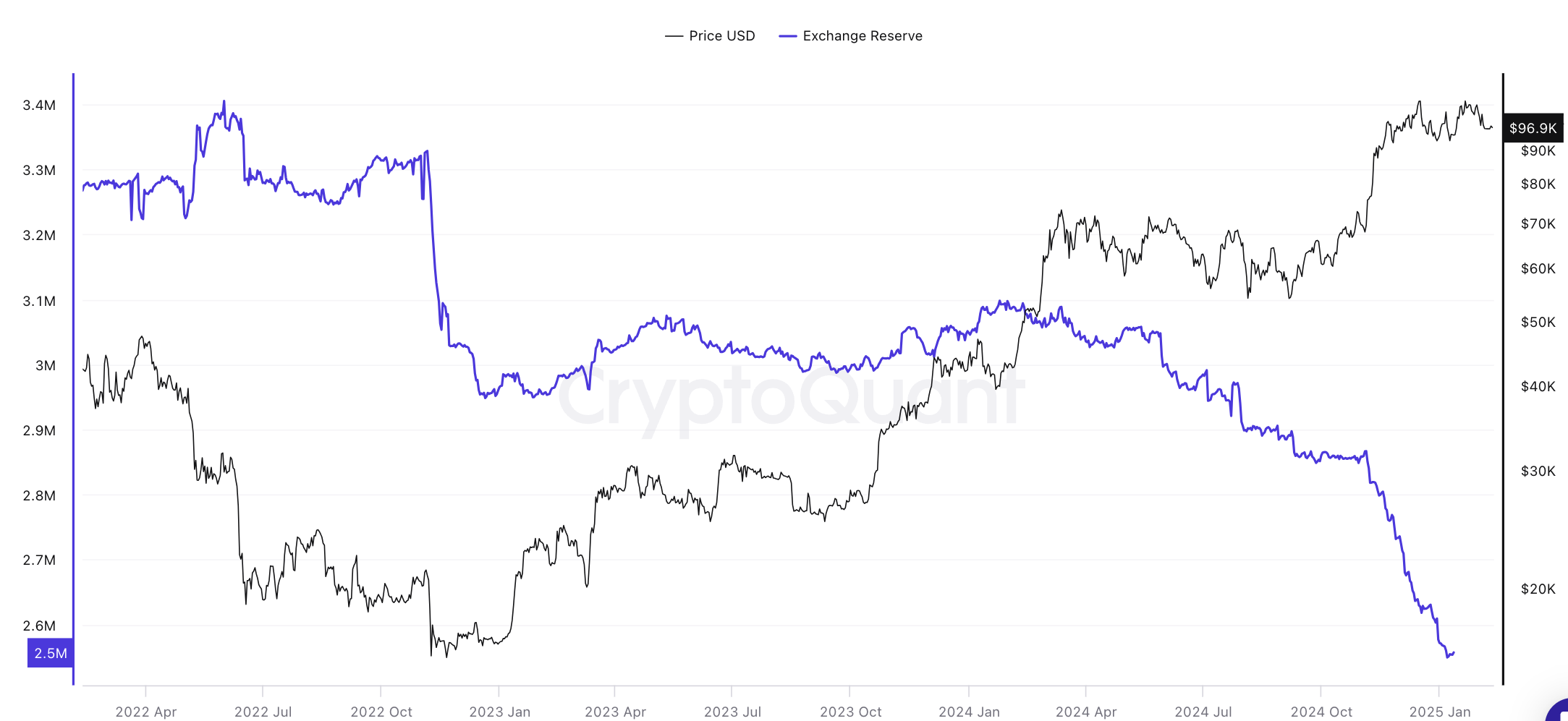| COINOTAG recommends • Exchange signup |
| 💹 Trade with pro tools |
| Fast execution, robust charts, clean risk controls. |
| 👉 Open account → |
| COINOTAG recommends • Exchange signup |
| 🚀 Smooth orders, clear control |
| Advanced order types and market depth in one view. |
| 👉 Create account → |
| COINOTAG recommends • Exchange signup |
| 📈 Clarity in volatile markets |
| Plan entries & exits, manage positions with discipline. |
| 👉 Sign up → |
| COINOTAG recommends • Exchange signup |
| ⚡ Speed, depth, reliability |
| Execute confidently when timing matters. |
| 👉 Open account → |
| COINOTAG recommends • Exchange signup |
| 🧭 A focused workflow for traders |
| Alerts, watchlists, and a repeatable process. |
| 👉 Get started → |
| COINOTAG recommends • Exchange signup |
| ✅ Data‑driven decisions |
| Focus on process—not noise. |
| 👉 Sign up → |
-
Bitcoin is potentially on the brink of a significant supply shock as exchange reserves plummet, drawing attention to shifting dynamics in the cryptocurrency market.
-
Despite financial volatility, long-term holders are increasingly acquiring Bitcoin, with only 2.5 million BTC remaining on exchanges.
-
Notably, this week marked the first outflow for Bitcoin ETFs in 2025, underscoring changing trends in institutional and retail investment.
As Bitcoin exchange reserves reach an all-time low, experts suggest a looming supply shock could reshape market dynamics in 2025.
Is Bitcoin Headed for a Supply Shock?
Bitcoin is entering a new chapter characterized by heightened interest from both retail and institutional investors. With exchange reserves falling to their lowest levels since tracking began in 2022, the market is witnessing unprecedented behavior.
Recent data suggests that ETF issuers are acquiring Bitcoin at an astounding rate, estimated to be 20 times faster than current mining outputs. This trend highlights a growing demand that is straining available supply and triggering concerns about future availability.

Bitcoin in Exchange Reserves at New Low. Source: CryptoQuant
| COINOTAG recommends • Professional traders group |
| 💎 Join a professional trading community |
| Work with senior traders, research‑backed setups, and risk‑first frameworks. |
| 👉 Join the group → |
| COINOTAG recommends • Professional traders group |
| 📊 Transparent performance, real process |
| Spot strategies with documented months of triple‑digit runs during strong trends; futures plans use defined R:R and sizing. |
| 👉 Get access → |
| COINOTAG recommends • Professional traders group |
| 🧭 Research → Plan → Execute |
| Daily levels, watchlists, and post‑trade reviews to build consistency. |
| 👉 Join now → |
| COINOTAG recommends • Professional traders group |
| 🛡️ Risk comes first |
| Sizing methods, invalidation rules, and R‑multiples baked into every plan. |
| 👉 Start today → |
| COINOTAG recommends • Professional traders group |
| 🧠 Learn the “why” behind each trade |
| Live breakdowns, playbooks, and framework‑first education. |
| 👉 Join the group → |
| COINOTAG recommends • Professional traders group |
| 🚀 Insider • APEX • INNER CIRCLE |
| Choose the depth you need—tools, coaching, and member rooms. |
| 👉 Explore tiers → |
As of now, approximately 2.5 million BTC remains on exchanges, a level not seen in the last three years. Investors have demonstrated a noteworthy shift in their behavior; ETF issuers might be flashy buyers, yet individual investors control about 69% of the total supply. This split signals that while institutional interest is strong, the backbone of Bitcoin’s market remains its individual holders.

US Spot Bitcoin ETF Net Inflows. Source: SoSoValue
| COINOTAG recommends • Exchange signup |
| 📈 Clear interface, precise orders |
| Sharp entries & exits with actionable alerts. |
| 👉 Create free account → |
| COINOTAG recommends • Exchange signup |
| 🧠 Smarter tools. Better decisions. |
| Depth analytics and risk features in one view. |
| 👉 Sign up → |
| COINOTAG recommends • Exchange signup |
| 🎯 Take control of entries & exits |
| Set alerts, define stops, execute consistently. |
| 👉 Open account → |
| COINOTAG recommends • Exchange signup |
| 🛠️ From idea to execution |
| Turn setups into plans with practical order types. |
| 👉 Join now → |
| COINOTAG recommends • Exchange signup |
| 📋 Trade your plan |
| Watchlists and routing that support focus. |
| 👉 Get started → |
| COINOTAG recommends • Exchange signup |
| 📊 Precision without the noise |
| Data‑first workflows for active traders. |
| 👉 Sign up → |
The current supply situation for Bitcoin is critical, with over 94% of the total supply already mined. With an ever-declining amount available, the risk of a supply crisis is more pronounced than ever. A modest increase in demand could ignite a substantial bull market.
Interestingly, the growing confidence among Bitcoin’s long-term holders is evident despite recent price downturns. The demand among Permanent Holders signifies optimism, pointing to their tendency to retain Bitcoin rather than sell during turbulent times. This could potentially lead to a supply shock, with many experiencing what is being noted as “holder fatigue.”
| COINOTAG recommends • Traders club |
| ⚡ Futures with discipline |
| Defined R:R, pre‑set invalidation, execution checklists. |
| 👉 Join the club → |
| COINOTAG recommends • Traders club |
| 🎯 Spot strategies that compound |
| Momentum & accumulation frameworks managed with clear risk. |
| 👉 Get access → |
| COINOTAG recommends • Traders club |
| 🏛️ APEX tier for serious traders |
| Deep dives, analyst Q&A, and accountability sprints. |
| 👉 Explore APEX → |
| COINOTAG recommends • Traders club |
| 📈 Real‑time market structure |
| Key levels, liquidity zones, and actionable context. |
| 👉 Join now → |
| COINOTAG recommends • Traders club |
| 🔔 Smart alerts, not noise |
| Context‑rich notifications tied to plans and risk—never hype. |
| 👉 Get access → |
| COINOTAG recommends • Traders club |
| 🤝 Peer review & coaching |
| Hands‑on feedback that sharpens execution and risk control. |
| 👉 Join the club → |
As highlighted by industry experts, immense institutional interest permeates the market. “Soon every billionaire will buy a billion dollars of Bitcoin and the supply shock will be so great that we’ll stop measuring BTC in terms of fiat,” stated Michael Saylor in a recent interview, emphasizing the substantial shift in market perception.
Furthermore, several U.S. states are pushing for the establishment of strategic Bitcoin reserves. Should these proposals gain traction, government purchases could significantly impact supply levels, making an already tenuous situation even more precarious.
Yet, potential macroeconomic influences, including fluctuating interest rates and international trade policies, will also be crucial in shaping Bitcoin’s future. Understanding these multi-faceted issues will be essential for investors navigating this evolving landscape.
Conclusion
The Bitcoin market is undoubtedly at a crossroads, with diminishing exchange reserves heralding a potential supply shock on the horizon. Investors should remain vigilant, as this shift could redefine Bitcoin’s trajectory in the coming months. Continued engagement with market developments and informed decision-making will be critical as the landscape changes.
| COINOTAG recommends • Exchange signup |
| 📈 Clear control for futures |
| Sizing, stops, and scenario planning tools. |
| 👉 Open futures account → |
| COINOTAG recommends • Exchange signup |
| 🧩 Structure your futures trades |
| Define entries & exits with advanced orders. |
| 👉 Sign up → |
| COINOTAG recommends • Exchange signup |
| 🛡️ Control volatility |
| Automate alerts and manage positions with discipline. |
| 👉 Get started → |
| COINOTAG recommends • Exchange signup |
| ⚙️ Execution you can rely on |
| Fast routing and meaningful depth insights. |
| 👉 Create account → |
| COINOTAG recommends • Exchange signup |
| 📒 Plan. Execute. Review. |
| Frameworks for consistent decision‑making. |
| 👉 Join now → |
| COINOTAG recommends • Exchange signup |
| 🧩 Choose clarity over complexity |
| Actionable, pro‑grade tools—no fluff. |
| 👉 Open account → |
| COINOTAG recommends • Members‑only research |
| 📌 Curated setups, clearly explained |
| Entry, invalidation, targets, and R:R defined before execution. |
| 👉 Get access → |
| COINOTAG recommends • Members‑only research |
| 🧠 Data‑led decision making |
| Technical + flow + context synthesized into actionable plans. |
| 👉 Join now → |
| COINOTAG recommends • Members‑only research |
| 🧱 Consistency over hype |
| Repeatable rules, realistic expectations, and a calmer mindset. |
| 👉 Get access → |
| COINOTAG recommends • Members‑only research |
| 🕒 Patience is an edge |
| Wait for confirmation and manage risk with checklists. |
| 👉 Join now → |
| COINOTAG recommends • Members‑only research |
| 💼 Professional mentorship |
| Guidance from seasoned traders and structured feedback loops. |
| 👉 Get access → |
| COINOTAG recommends • Members‑only research |
| 🧮 Track • Review • Improve |
| Documented PnL tracking and post‑mortems to accelerate learning. |
| 👉 Join now → |








